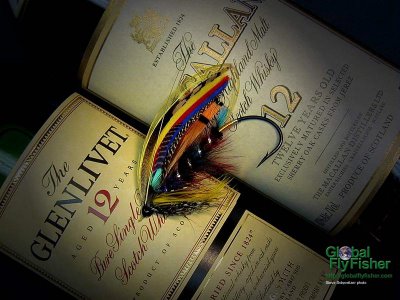Saturday, February 25, 2006
Friday, February 24, 2006
Upstream: a unique view of fly fishing
 Last spring, the Two Brothers had an opportunity to view an exhibit of photos taken by Charles Lindsay. The exhibit, entitled "Upstream", allowed the non-fly fisher a glimpse into the world that we marvel at each time we cast a line, and yet take for granted as we've seen it so many times.
Last spring, the Two Brothers had an opportunity to view an exhibit of photos taken by Charles Lindsay. The exhibit, entitled "Upstream", allowed the non-fly fisher a glimpse into the world that we marvel at each time we cast a line, and yet take for granted as we've seen it so many times.The travelling exhibit itself consists of 27 images, enlarged to 40"x40", that eschew the grandiose views and beautiful sunrises and sunsets that have become photographic cliches. Instead, Lindsay focuses (quite literally) on the details that make up a day on the water... a rod bent by a fighting fish... a cichlid hatch... a fly snared by streamside vegetation... and even a few photos of the fish themselves.
For anyone who has futily tried to explain the joys and frustrations of our favorite pasttime to uninitiated friends and family, this is likely the closest they'll ever get to being able to see as we do. The photos are vivid and haunting in a way that will make you dig out your fly box and start cleaning your lines.
And for those who won't be able to see the exhibit itself, you're still in luck. Lindsay teamed up with Thomas McGuane (yes, THAT Thomas McGuane) to put together the book. You can get it here.
Thursday, February 23, 2006
Podcasts for fly fishers
I've never listened to a podcast because I've never found one that covered a topic I wanted to hear about. But Fly Fish Radio changes every thing.
Gear Geek Alert: Stripping basket worth checking out
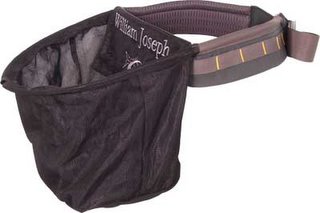
As a seasoned fly fisher, I think I speak for all of us when I say that when we prepare to head out for a full day of fishing, we relish the idea of packing as much gear as possible into our vests, wading jacket, shirt pockets and pants. The more the merrier, we feel. Especially if we know we'll be on the water for a long time (and subconsciously know we'll be carrying around all that weight for hours on end).
That is why I take it upon myself to search out even more gear for each and every one of us to add to our list of essentials. I believe I've found something that most of us probably didn't even realize we can't live without. For that reason, I present to you the William Joseph Retractable Stripping Basket.
The description, taken directly from the company website, says "Our Retractable Stripping Basket acts as a wading belt and a utility belt (holds tools, water, etc.) plus when it is time to fish, simply give it a yank and out pops the basket, ready to catch your line."
There are times when using a stripping basket is an obvious advantage. In a canoe or boat, in order to prevent the line from tangling on other gear... when fishing the flats for stripers... or on fast flowing rivers that will carry your line away as quickly as you bring it in. However, my fishing is practically never done in those conditions. I prefer small streams and slower gin-clear pocket water that is prevalent in the midwest. As long as I keep my line out of the streamside weeds or the occasional half-submerged log, I should be fine. Of course that's much easier said than done, but for reasons we don't need to go into right now.
Still, a stripping basket has been on my wish list for years now. I live about two hours from the closest decent trout water, so when I am able to make a day of it, I'm usually looking at 4 hours of combined driving. For that reason, if no other, I try to maximize my time on the water, often spending 6 hours standing in the drink. That means my fly line is in the water for the 5 hours that it isn't hung up in tree branches and the aforementioned weeds. No matter how clean my line is before heading out, and how diligent I try to be about cleaning it throughout the day, the fact is that the longer it stays in the water, the quicker it starts to lose its bouyancy. And the one thing I can't stand is having my leader being dragged under the surface by a floating line that refuses to float. It makes sense that stripping it into a basket would be better than dropping it by my side, often in weeds or mud. And maybe I'm the only one who takes a step upstream while casting, only to find the line wrapped nice and tight around my leg. I doubt the fish are impressed by my less than graceful maneuver of lifting one boot up high enough to pull the line off my gravel guard, and then put the same foot down with a splash that sounds like a gunshot to a brookie. It sure would be nice to have something to stop me from looking like a drunk clown in waders. Even if it amuses the fish.
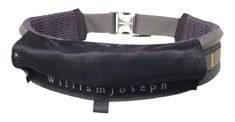 Which brings us back to the John Williams stripping basket. it's little more than a heavy-duty wading belt, with a webbed pouch that pulls out when you need it. From what I can see, it also has loops to attach a few zingers, tools, water bottle holders, et cetera. Think of it as a waist-level lanyard and wading belt in one.
Which brings us back to the John Williams stripping basket. it's little more than a heavy-duty wading belt, with a webbed pouch that pulls out when you need it. From what I can see, it also has loops to attach a few zingers, tools, water bottle holders, et cetera. Think of it as a waist-level lanyard and wading belt in one.Now I imagine some of you might be wondering what John Williams is paying me for this endorsement. I'm kinda wondering that, too. I would suggest an all-expense paid guided trip to New Zealand, if they're reading this. The fact is that I have yet to see this wading basket/belt in person so I'll have to get back to this when the weather warms up and I find one to try out. But I have to admit that the possibility of summertime wet wading in a pair of shorts, sandals and this belt is making me wish spring would hurry up and kick in. As if I needed another reason to want that.
Wednesday, February 22, 2006
Sunday, February 19, 2006
"I'd wear a coat"
The closer we get to early trout season, the further away it seems to be. Having had a nearly snowless winter, with temperatures averaging in the mid 30s for much of the season, we suddenly get hit with a good old fashioned blizzard, and yesterday the mercury dipped into the sub-zero range. Not exactly what I'd call prime fishing weather. But there are others who would disagree. As in the case with this article by Kevin Kling.
Every year the call goes out: the ice is safe. Open water has turned into prime real estate, and villages of tiny shacks pop up overnight. Thus ice-fishing season opens in Minnesota, home of the nation’s icebox, where carpaccio is still made with carp and especially frigid winters are referred to by their year, like fine wine. Although months of subzero temperatures test the heartiest souls, some people actually live in this state on purpose. As I overheard one Northern gentleman say, “When you freeze paradise, it’s bound to last a little longer."
Mille Lacs Lake is one of the most popular spots for ice fishing in the Land of 10,000 Lakes. It covers more than 200 square miles in the middle of Minnesota and is known for its walleye, arguably the best-tasting fish you can pull from fresh water. Once the ice sets—late November or early December, depending—local resort owners start renting out ice-fishing houses and hauling them out onto the lake, where bars, churches and the random bowling alley follow. By January, there will be around 5,000 angling abodes on the ice, which qualifies as a small city in Minnesota. (And at Gull Lake, more than 9,000 folks competed in last year’s annual Brainerd Jaycees Ice Fishing Extravaganza, but that’s a one-day affair involving less housing.)
To most people below the 48th parallel, ice fishing must seem like pounding your head against the wall, in that it’s not doing it in the first place that makes the most sense. While it’s true that it’s not for everyone, it sure beats staying cooped up inside your house for six months. Here are some basics to get you started:
First, find a spot on the lake where the ice is thick enough to support your car without its dropping through. If you’re unsure, watch someone else drive out first. Next, auger a fishing hole in the ice. An ice auger is like a posthole digger with a large screwlike cutting blade rotated by hand or motor. In the fun department, the powered ice auger sits just behind the chain saw and way ahead of the power leaf blower.
Most people opt for an ice-fishing house, a 10- by 16-foot shack with a propane stove and holes in the floor. The holes are usually covered by hinged plywood that can be flipped up for fishing. Some fishing houses are rudimentary, but others come with stereos, TVs, kitchens, bunk beds, couches, or even hot tubs and saunas parked next door. Ice anglers tend to have a lot invested in their fish houses. The shacks are usually painted to reflect the owner’s personality, hobby, favorite sports franchise or cause. On the lake, brilliant colors are an advantage. An all-white house probably wouldn’t be found until spring.
You’ll need an ice-fishing pole with a reel, monofilament line and bobber. An ice-fishing pole looks pretty much like any other fishing pole but shorter, since casting isn’t an option. You’ll need a skimmer, or slotted ladle, for clearing out the ice that will form on the hole, and a five-gallon plastic bucket to haul your gear and your catch, or “tonnage.” For bait, use a minnow or wax worm on a hook with a brightly colored weight. The best fishing is usually just off the bottom of the lake, which is only about 40 feet deep at most. A slight tug, or “jigging,” on the line every few seconds draws attention to the bait.
There are other ways to increase your luck, such as using feeding-time charts and depth finders and topographic maps of the lake bottom that show ridges and shoals. Every fisher man or woman has a secret weapon, a lure that will make a fish react against its better judgment, whether by seduction, rage or appetite. Some folks spray their lures with fish oil to take away the human scent. (A word of caution: keep the fish oil away from the beer.)
The fun of ice fishing is that you never know what you might catch: perch, trout, northern pike, muskie, crappie—even the coveted walleye. Or you can drop a line down deep and try to snag something prehistoric with a lantern on its head. You just don’t know what’s going to come out of that hole. Maybe a trophy fish—something to take to the taxidermist, maybe a reason to fix up the basement, put a piece of shag carpet over the oil stain, make wise investments with confidence gained and spend more time with the family. A whole world of new possibilities opens. I heard about one guy who felt a tug on his line and pulled up sharply to set the hook. There was a tremendous fight until finally up through the hole came a license plate. He threw the plate in the corner and was rebaiting his line when he had a fearsome epiphany. He ran outside to see the hole in the ice where his truck had been. (That one may be apocryphal.)
We used to call ice fishing “sitting around practicing for when we got old,” but now we just call it “sitting around.” Many fisherpeople use a “tip-up,” a device that sends up a flag when a fish bites. This frees one to multitask—that is, fish and play cards, fish and watch TV, fish and learn Spanish, and so on. Other warning systems include buzzers, bells, whistles, car alarms and voice-activated computers (“I believe you have a fish, Dave”). I knew a high-school band teacher who rigged cymbals to crash when a fish took the bait.
Northern Minnesota is known for its stoic Nordic types, but to ice fish I think you also have to have a sense of humor. The people, like the weather, seem cold at first, but then you get used to them. Just remember: when a guy sitting next to you doesn’t talk to you for hours, it doesn’t mean he doesn’t like you. If he then asks, “Cold enough for you?” take it as a sign of affection. Answer with, “I’d wear a coat,” and you’ll be fine.
Every year the call goes out: the ice is safe. Open water has turned into prime real estate, and villages of tiny shacks pop up overnight. Thus ice-fishing season opens in Minnesota, home of the nation’s icebox, where carpaccio is still made with carp and especially frigid winters are referred to by their year, like fine wine. Although months of subzero temperatures test the heartiest souls, some people actually live in this state on purpose. As I overheard one Northern gentleman say, “When you freeze paradise, it’s bound to last a little longer."
Mille Lacs Lake is one of the most popular spots for ice fishing in the Land of 10,000 Lakes. It covers more than 200 square miles in the middle of Minnesota and is known for its walleye, arguably the best-tasting fish you can pull from fresh water. Once the ice sets—late November or early December, depending—local resort owners start renting out ice-fishing houses and hauling them out onto the lake, where bars, churches and the random bowling alley follow. By January, there will be around 5,000 angling abodes on the ice, which qualifies as a small city in Minnesota. (And at Gull Lake, more than 9,000 folks competed in last year’s annual Brainerd Jaycees Ice Fishing Extravaganza, but that’s a one-day affair involving less housing.)
To most people below the 48th parallel, ice fishing must seem like pounding your head against the wall, in that it’s not doing it in the first place that makes the most sense. While it’s true that it’s not for everyone, it sure beats staying cooped up inside your house for six months. Here are some basics to get you started:
First, find a spot on the lake where the ice is thick enough to support your car without its dropping through. If you’re unsure, watch someone else drive out first. Next, auger a fishing hole in the ice. An ice auger is like a posthole digger with a large screwlike cutting blade rotated by hand or motor. In the fun department, the powered ice auger sits just behind the chain saw and way ahead of the power leaf blower.
Most people opt for an ice-fishing house, a 10- by 16-foot shack with a propane stove and holes in the floor. The holes are usually covered by hinged plywood that can be flipped up for fishing. Some fishing houses are rudimentary, but others come with stereos, TVs, kitchens, bunk beds, couches, or even hot tubs and saunas parked next door. Ice anglers tend to have a lot invested in their fish houses. The shacks are usually painted to reflect the owner’s personality, hobby, favorite sports franchise or cause. On the lake, brilliant colors are an advantage. An all-white house probably wouldn’t be found until spring.
You’ll need an ice-fishing pole with a reel, monofilament line and bobber. An ice-fishing pole looks pretty much like any other fishing pole but shorter, since casting isn’t an option. You’ll need a skimmer, or slotted ladle, for clearing out the ice that will form on the hole, and a five-gallon plastic bucket to haul your gear and your catch, or “tonnage.” For bait, use a minnow or wax worm on a hook with a brightly colored weight. The best fishing is usually just off the bottom of the lake, which is only about 40 feet deep at most. A slight tug, or “jigging,” on the line every few seconds draws attention to the bait.
There are other ways to increase your luck, such as using feeding-time charts and depth finders and topographic maps of the lake bottom that show ridges and shoals. Every fisher man or woman has a secret weapon, a lure that will make a fish react against its better judgment, whether by seduction, rage or appetite. Some folks spray their lures with fish oil to take away the human scent. (A word of caution: keep the fish oil away from the beer.)
The fun of ice fishing is that you never know what you might catch: perch, trout, northern pike, muskie, crappie—even the coveted walleye. Or you can drop a line down deep and try to snag something prehistoric with a lantern on its head. You just don’t know what’s going to come out of that hole. Maybe a trophy fish—something to take to the taxidermist, maybe a reason to fix up the basement, put a piece of shag carpet over the oil stain, make wise investments with confidence gained and spend more time with the family. A whole world of new possibilities opens. I heard about one guy who felt a tug on his line and pulled up sharply to set the hook. There was a tremendous fight until finally up through the hole came a license plate. He threw the plate in the corner and was rebaiting his line when he had a fearsome epiphany. He ran outside to see the hole in the ice where his truck had been. (That one may be apocryphal.)
We used to call ice fishing “sitting around practicing for when we got old,” but now we just call it “sitting around.” Many fisherpeople use a “tip-up,” a device that sends up a flag when a fish bites. This frees one to multitask—that is, fish and play cards, fish and watch TV, fish and learn Spanish, and so on. Other warning systems include buzzers, bells, whistles, car alarms and voice-activated computers (“I believe you have a fish, Dave”). I knew a high-school band teacher who rigged cymbals to crash when a fish took the bait.
Northern Minnesota is known for its stoic Nordic types, but to ice fish I think you also have to have a sense of humor. The people, like the weather, seem cold at first, but then you get used to them. Just remember: when a guy sitting next to you doesn’t talk to you for hours, it doesn’t mean he doesn’t like you. If he then asks, “Cold enough for you?” take it as a sign of affection. Answer with, “I’d wear a coat,” and you’ll be fine.
Thursday, February 16, 2006
And then depression set in

Anyone who has been reading this blog lately is aware of my burning desire to get winter done with and move on to more important things. Like.. oh, fishing. Well, Mother Nature considered my comments of that sort to be rather impudent and has reminded me, and everyone within a 100 mile radius, who is really in charge.
 The Snow Miser was granted freedom to do what he does best. Within 12 hours, our previously brown landscape has been turned into a blustery white tundra. I wouldn't be a bit surprised to see a Coca-Cola polar bear Christmas commercial being filmed outside my door. My usual 5 minute work commute was turned into an hour stop and go drive on the highway. But at least I could keep myself occupied by counting the cars in the ditch. I lost count around 20. This is one of those days where the investment I made 4 years ago in a car with all-wheel drive and snowtires has definitely paid off.
The Snow Miser was granted freedom to do what he does best. Within 12 hours, our previously brown landscape has been turned into a blustery white tundra. I wouldn't be a bit surprised to see a Coca-Cola polar bear Christmas commercial being filmed outside my door. My usual 5 minute work commute was turned into an hour stop and go drive on the highway. But at least I could keep myself occupied by counting the cars in the ditch. I lost count around 20. This is one of those days where the investment I made 4 years ago in a car with all-wheel drive and snowtires has definitely paid off. It's so nasty outside that my cellular service is currently down. I feel like Bill Murray in Groundhog Day asking the telephone operator if it's snowing in space.
So here we are, two and a half weeks from Opening Day, and hit by the worst storm we've seen in years. I'm sorry, Mother Nature.
Wednesday, February 15, 2006
Castaway
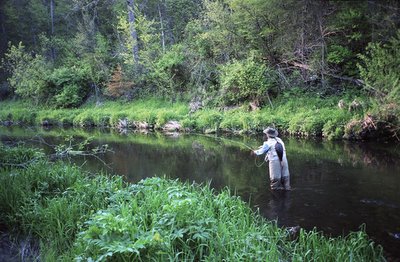
Just a reminder of what's to come, as well as days gone by. It was a beautiful day (aren't they all when you're fishing?) on a well-known Wisconsin trout stream. The fish weren't as cooperative as we had hoped, but we managed to coax a few into our nets.
Tuesday, February 14, 2006
A Beer Lover's Guide To Fly Fishing
an excerpt from the article printed in 'All About Beer Magazine', Sept. 2002
When you think of fly fishing, you probably envision a guy standing knee deep in a pristine trout stream set against a breathtaking backdrop of snow-capped mountains, rhythmically casting a fly rod in time with nature. While it is true that trout inhabit such inspiring places, limiting your fly fishing to trout is like limiting your beer drinking to lager. Fortunately for beer lovers and fly fishers, lots of options exist for both passions. The most fortunate thing of all is that drinking beer and fly fishing naturally go together. After all, any fly fisher knows that you can't always count on the fish to cooperate, but you can always count on a good beer when the day is done.
"We all know it is a theoretical impossibility to catch fish without beer," says John "JB" Shireman of the New Belgium Brewing Co. in Fort Collins, CO. "At the very least," Shireman continues, "it's poor form. Fishing and beer drinking are two endeavors in any sporting gent's life that evolve over time. While a cooler of cheap domestics and a worm tub once sufficed, no one worthy of the title, Fly Fisherman, would defile a Mackenzie [drift] boat with anything less than a hand-crafted ale in one hand and a nice fly rod in the other."
I would have to agree. In fact, I will even go one step farther and say that fly fishing makes beer taste better. By far the best tasting beer I ever had was a cheap macrobrew consumed after my brother and I spent five days in the Bridger Wilderness Area of Wyoming chasing cutthroat trout. Or maybe the best-tasting beer was the one I shared with my Padre fishing buddies celebrating my first "tailing" redfish caught on the fly. Or maybe it was the beer my dad and I shared after a Father's Day spent catching dozens of red-breasted sunfish. Or... (well, you get the idea.)
Then, again, maybe the real connection between beer and fly fishing is the nostalgia of sharing a day on the water with someone important to you.
Cindy Burchfield, marketing director at Alaskan Brewing Co., treasures wedding anniversaries spent fishing with her husband. "I can't think of a more romantic way to celebrate: working together, the thrill of the reel, fighting a 15 pound silver salmon. We keep beer on board the boat, but just for good luck: we drink it later. Beer and fishing both bring people together."
"I brew beer, and I fish. In fact, I brew to fish," says Dean Schemenauer of Leinenkugel's Tenth Street Brewery in Milwaukee. "A good beer is the proper finish to a day of fishing with my brothers. When you're done, you can say the fishing was great, the catching was lousy, and the beer was cold."
For Greg Owsley, also with New Belgium Brewing Co., the hook was the many great summer days spent fly fishing the Conejos River in southern Colorado with his grandfather, dad and uncles. His grandparents' cabin was too far away to walk for a beer, so they would stash some behind a certain boulder in the water. Greg recalls that, "When I was too young to admit, Papa and I beat the others back to the beer hole one evening. He opened a beer, handed it over, opened another, clinked mine and winked at me. Before doubt muddied the waters, I seized the clear opportunity I had been graciously cast and guzzled all 12 ounces."
Terry Hackett is an environmental consultant who would rather spend his time fly fishing or writing about fly fishing. When not on the water, you can find him at his brother's fly shop in Durham, NC, tying flies and enjoying a cold brew.
When you think of fly fishing, you probably envision a guy standing knee deep in a pristine trout stream set against a breathtaking backdrop of snow-capped mountains, rhythmically casting a fly rod in time with nature. While it is true that trout inhabit such inspiring places, limiting your fly fishing to trout is like limiting your beer drinking to lager. Fortunately for beer lovers and fly fishers, lots of options exist for both passions. The most fortunate thing of all is that drinking beer and fly fishing naturally go together. After all, any fly fisher knows that you can't always count on the fish to cooperate, but you can always count on a good beer when the day is done.
"We all know it is a theoretical impossibility to catch fish without beer," says John "JB" Shireman of the New Belgium Brewing Co. in Fort Collins, CO. "At the very least," Shireman continues, "it's poor form. Fishing and beer drinking are two endeavors in any sporting gent's life that evolve over time. While a cooler of cheap domestics and a worm tub once sufficed, no one worthy of the title, Fly Fisherman, would defile a Mackenzie [drift] boat with anything less than a hand-crafted ale in one hand and a nice fly rod in the other."
I would have to agree. In fact, I will even go one step farther and say that fly fishing makes beer taste better. By far the best tasting beer I ever had was a cheap macrobrew consumed after my brother and I spent five days in the Bridger Wilderness Area of Wyoming chasing cutthroat trout. Or maybe the best-tasting beer was the one I shared with my Padre fishing buddies celebrating my first "tailing" redfish caught on the fly. Or maybe it was the beer my dad and I shared after a Father's Day spent catching dozens of red-breasted sunfish. Or... (well, you get the idea.)
Then, again, maybe the real connection between beer and fly fishing is the nostalgia of sharing a day on the water with someone important to you.
Cindy Burchfield, marketing director at Alaskan Brewing Co., treasures wedding anniversaries spent fishing with her husband. "I can't think of a more romantic way to celebrate: working together, the thrill of the reel, fighting a 15 pound silver salmon. We keep beer on board the boat, but just for good luck: we drink it later. Beer and fishing both bring people together."
"I brew beer, and I fish. In fact, I brew to fish," says Dean Schemenauer of Leinenkugel's Tenth Street Brewery in Milwaukee. "A good beer is the proper finish to a day of fishing with my brothers. When you're done, you can say the fishing was great, the catching was lousy, and the beer was cold."
For Greg Owsley, also with New Belgium Brewing Co., the hook was the many great summer days spent fly fishing the Conejos River in southern Colorado with his grandfather, dad and uncles. His grandparents' cabin was too far away to walk for a beer, so they would stash some behind a certain boulder in the water. Greg recalls that, "When I was too young to admit, Papa and I beat the others back to the beer hole one evening. He opened a beer, handed it over, opened another, clinked mine and winked at me. Before doubt muddied the waters, I seized the clear opportunity I had been graciously cast and guzzled all 12 ounces."
Terry Hackett is an environmental consultant who would rather spend his time fly fishing or writing about fly fishing. When not on the water, you can find him at his brother's fly shop in Durham, NC, tying flies and enjoying a cold brew.
Monday, February 13, 2006
Are we there yet?
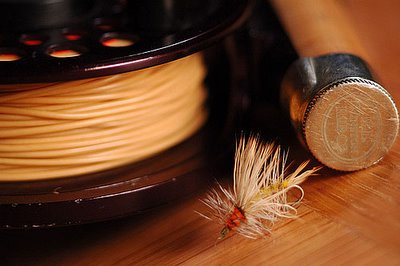
March 4th (opening day for the 'early' trout season in Wisconsin) is only three weeks away. Three very long weeks. But considering that we currently have snow flurries, and the temperature is a balmy 25 degrees outside, I think I'll be able to hold off.
Ironically, I was out geocaching yesterday, and one of the caches was located right beside a Lake Michigan tributary popular among steelheader and lake trout fishermen. As I was about to get into my car after successfully locating the cache, another car pulled off the road right behind me. A friendly-looking guy, probably in his mid 20s, hopped out and grabbed a fly rod out of his trunk. After quickly introducting myself as a fellow fly fisher, he smiled and said "I can only tie just so many flies. I had to get out today, even if I don't catch anything." I nodded in understanding.
The way we see it
"There is, to me, no feeling quite comparable to that experienced after studying a river and its environs, correctly selecting the appropriate fly, laying it gently where it will drift naturally to the chosen spot, and then, suddenly, watching it be taken by the intended prey. A quick flick of the wrist sets the hook and then the water explodes with the frenzied fight of a contending trophy King salmon, steelhead, rainbow, cutthroat, brown, or brookie. To have outwitted the ever-cautious instincts of the adversary is but the beginning, for it is the play and the netting that is the main event.
To those who think of flyfishing as sport, I pray we never meet. Flyfishing may be many things, but sport should not be one of them. On the one hand, it is the natural extension of the art of fly-tying and, on the other, is an art unto itself. But, in its sublime essence resides a respect for and communion with nature and life. As a process, flyfishing is an integration of understanding, of presentation, of skill and cunning, all subconsciously interwoven and operating while the fisherman's mind drifts, reflects, contemplates, and appreciates among endlessly changing vistas. Only when the fly is taken is focus required, for all else is, or at least should be, both outwardly reflexive while inwardly relaxing, therapeutic and almost spiritual by design. These attributes belong to no sport of which I know.
To flyfish for food is acceptable where allowed and needed, but to release the catch back into its native habitat--not to be caught again another day, but to honor its struggle for survival--is to give ultimate homage to the fish and the art of catching it, and elevates the mere flyfisherman to the realm of reverent naturalist."
Jack B. Keller, Jr.
To those who think of flyfishing as sport, I pray we never meet. Flyfishing may be many things, but sport should not be one of them. On the one hand, it is the natural extension of the art of fly-tying and, on the other, is an art unto itself. But, in its sublime essence resides a respect for and communion with nature and life. As a process, flyfishing is an integration of understanding, of presentation, of skill and cunning, all subconsciously interwoven and operating while the fisherman's mind drifts, reflects, contemplates, and appreciates among endlessly changing vistas. Only when the fly is taken is focus required, for all else is, or at least should be, both outwardly reflexive while inwardly relaxing, therapeutic and almost spiritual by design. These attributes belong to no sport of which I know.
To flyfish for food is acceptable where allowed and needed, but to release the catch back into its native habitat--not to be caught again another day, but to honor its struggle for survival--is to give ultimate homage to the fish and the art of catching it, and elevates the mere flyfisherman to the realm of reverent naturalist."
Jack B. Keller, Jr.
